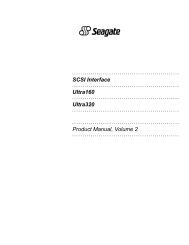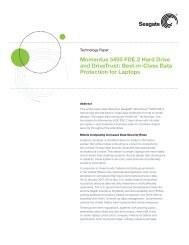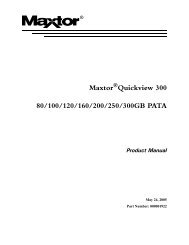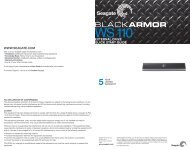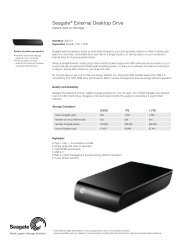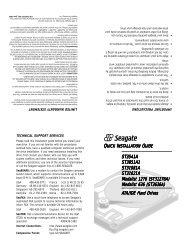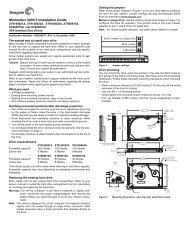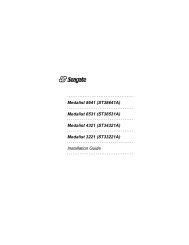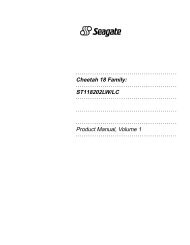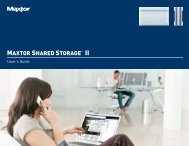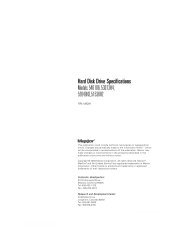Barracuda 18LP Family: ST39175LW/LC ST318275LW ... - Seagate
Barracuda 18LP Family: ST39175LW/LC ST318275LW ... - Seagate
Barracuda 18LP Family: ST39175LW/LC ST318275LW ... - Seagate
Create successful ePaper yourself
Turn your PDF publications into a flip-book with our unique Google optimized e-Paper software.
<strong>Barracuda</strong> <strong>18LP</strong> Product Manual, Rev. E 31<br />
7.0 Defect and error management<br />
The drive, as delivered, complies with this specification. The read error rate and specified storage capacity are<br />
not dependent upon use of defect management routines by the host (initiator).<br />
Defect and error management in the SCSI system involves the drive internal defect/error management and<br />
SCSI systems error considerations (errors in communications between Initiator and the drive). Tools for use in<br />
designing a defect/error management plan are briefly outlined in this section, with references to other sections<br />
where further details are given.<br />
7.1 Drive internal defects<br />
During the initial drive format operation at the factory, media defects are identified, tagged as being unusable,<br />
and their locations recorded on the drive primary defects list (referred to as the “P” list and also as the EFT<br />
defect list). At factory format time, these known defects are also reallocated, that is, reassigned to a new place<br />
on the medium and the location listed in the defects reallocation table. The “P” list is not altered after factory<br />
formatting. Locations of defects found and reallocated during error recovery procedures after drive shipment<br />
are listed in the “G” list (defects growth list). The “P” and “G” lists may be referenced by the initiator using the<br />
Read Defect Data command (refer to the SCSI Interface Product Manual, part number 77738479).<br />
7.2 Drive error recovery procedures<br />
Whenever an error occurs during drive operation, the drive, if programmed to do so, performs error recovery<br />
procedures to attempt to recover the data. The error recovery procedures used depend on the options previously<br />
set up in the error recovery parameters mode page. Error recovery and defect management may involve<br />
the use of several SCSI commands, the details of which are described in the SCSI Interface Product Manual.<br />
The drive implements selectable error recovery time limits such as are required in video applications. For additional<br />
information on this, refer to the Error Recovery Page table in the SCSI Interface Product Manual, which<br />
describes the Mode Select/Mode Sense Error Recovery parameters.<br />
The error recovery scheme supported by the drive provides a means to control the total error recovery time for<br />
the entire command in addition to controlling the recovery level for a single LBA. The total amount of time spent<br />
in error recovery for a command can be limited via the Recovery Time Limit bytes in the Error Recovery Mode<br />
Page. The total amount of time spent in error recovery for a single LBA can be limited via the Read Retry Count<br />
or Write Retry Count bytes in the Error Recovery Mode Page.<br />
The drive firmware error recovery algorithms consist of 12 levels for read recoveries and 16 levels for writes.<br />
Table 4 equates the Read and Write Retry Count with the maximum possible recovery time for read and write<br />
recovery of individual LBAs. The times given do not include time taken to perform reallocations, if reallocations<br />
are performed. Reallocations are performed when the ARRE bit (for reads) or AWRE bit (for writes) is one, the<br />
RC bit is zero, and the Recovery Time Limit for the command has not yet been met. Time needed to perform<br />
reallocation is not counted against the Recovery Time Limit.<br />
The Read Continuous (RC) bit, when set to one, requests the disc drive to transfer the requested data length<br />
without adding delays (for retries or ECC correction) that may be required to insure data integrity. The disc<br />
drive may send erroneous data in order to maintain the continuous flow of data. The RC bit should only be<br />
used when data integrity is not a concern and speed is of utmost importance. If the Recovery Time Limit or<br />
retry count is reached during error recovery, the state of the RC bit is examined. If the RC bit is set, the drive<br />
will transfer the unrecovered data with no error indication and continue to execute the remaining command. If<br />
the RC bit is not set, the drive will stop data transfer with the last good LBA, and report a “CHECK CONDI-<br />
TION, UNRECOVERED READ ERROR.”



